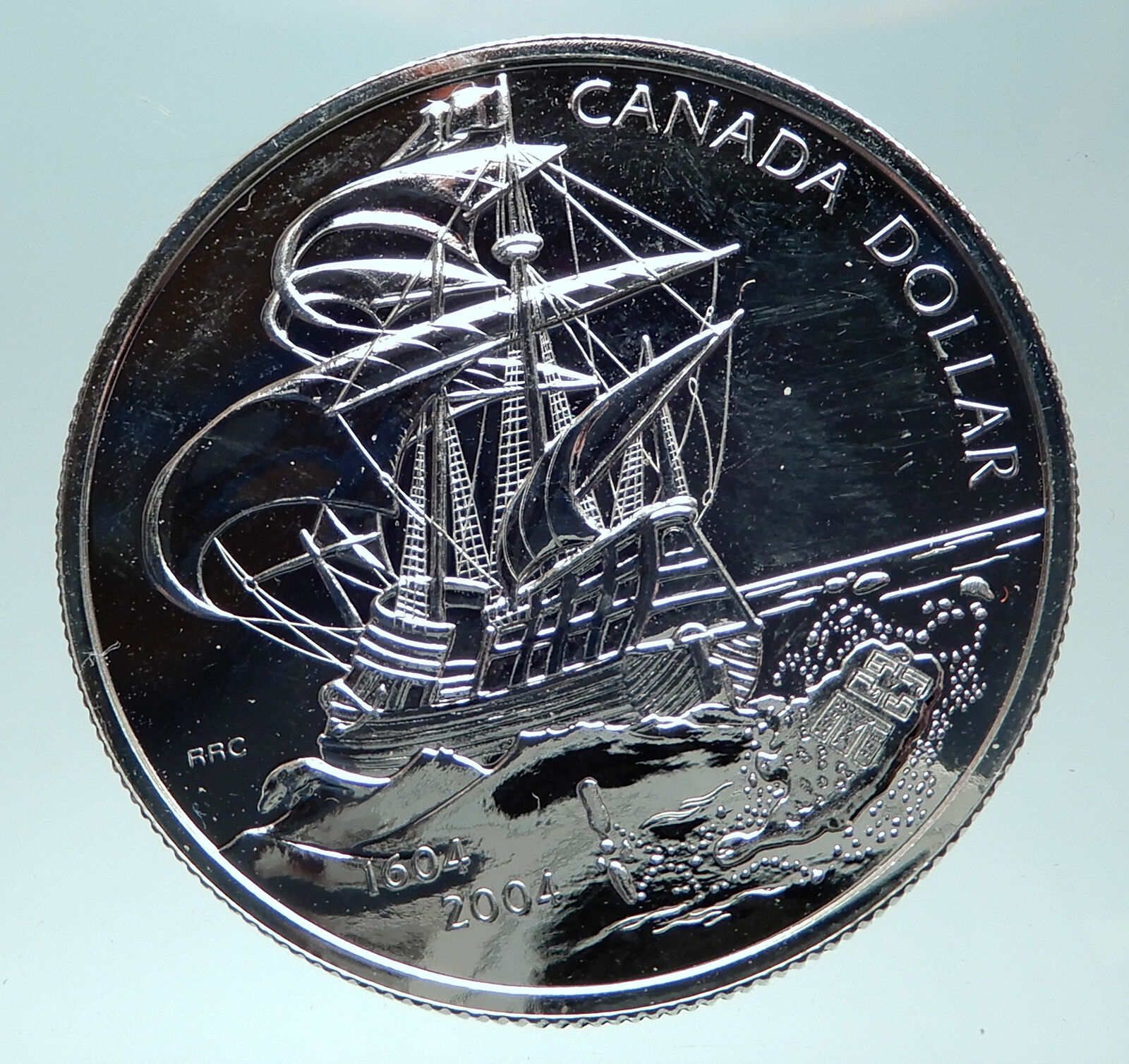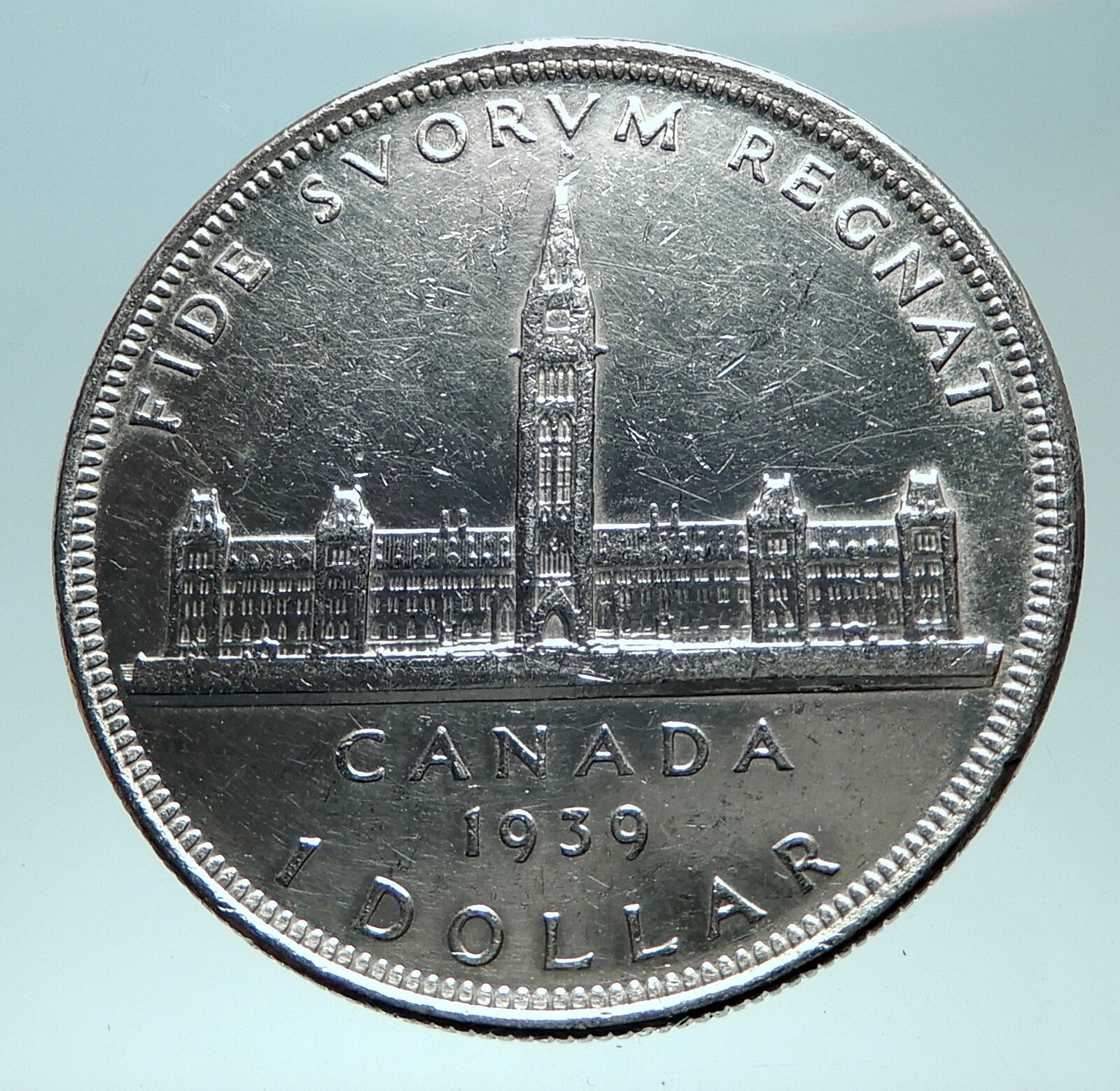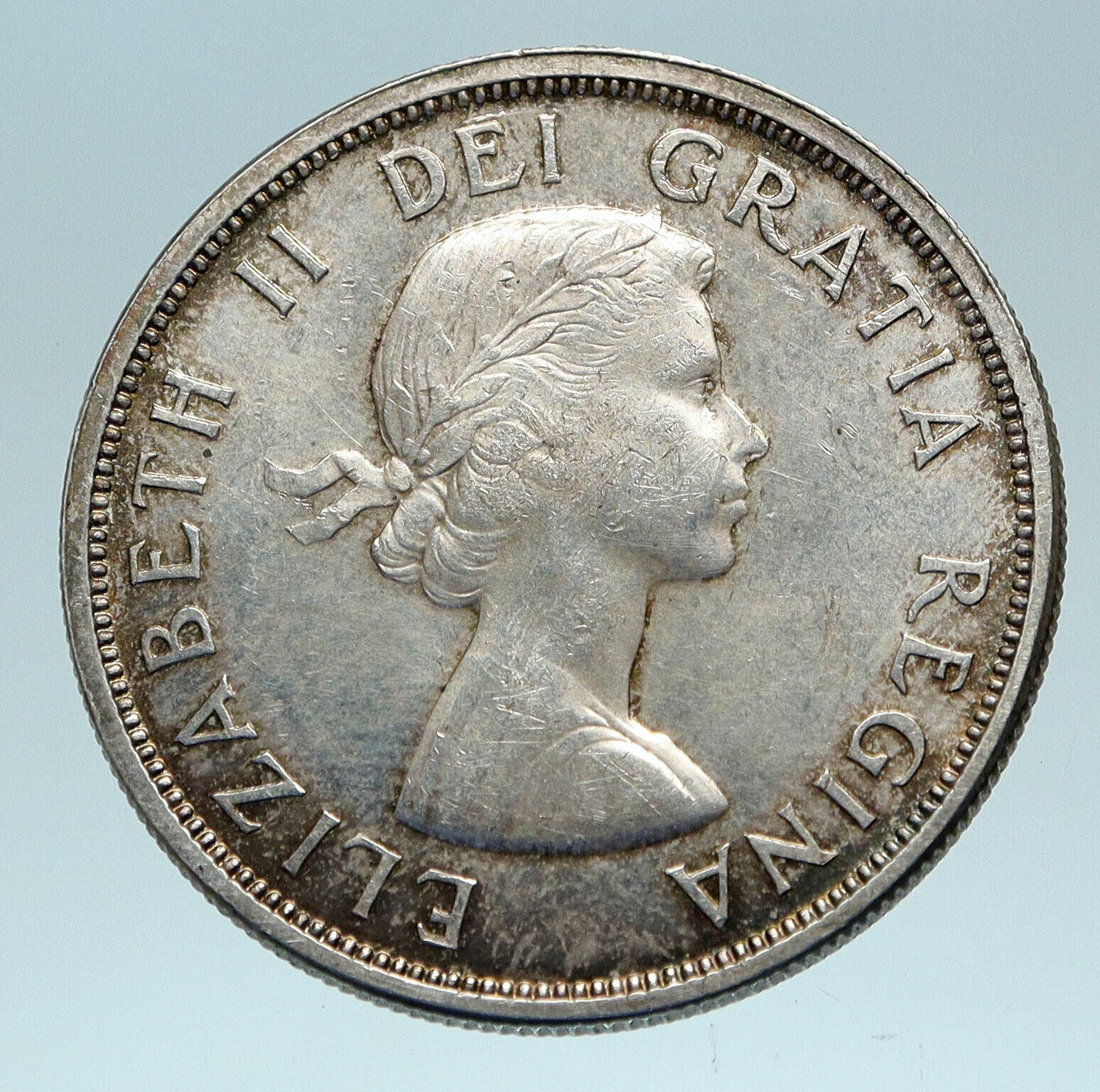|
Canada under Elizabeth II – Queen: 6 February 1952–present
Proof Set of 7 Coins
The Silver coin is:
300th Anniversary of the Ventures of Henry Kelsey
1990 Proof Silver Dollar 36mm (23.33 grams) 0.500 Silver (0.3750 oz. ASW)
Reference: KM# 170
ELIZABETH II D·G·R EGINA, Elizabeth facing right.
CANADA DOLLAR 1690 KELSEY 1990, Henry Kelsey with Indians.
You are bidding on the exact item pictured, provided with a Certificate of Authenticity and Lifetime Guarantee of Authenticity.
 Henry Kelsey (c. 1664 – 1 November 1724) was an English fur trader, explorer, and sailor who played an important role in establishing the Hudson’s Bay Company in Canada. Kelsey was born in 1667 and married in East Greenwich, south-east of central London. Henry Kelsey (c. 1664 – 1 November 1724) was an English fur trader, explorer, and sailor who played an important role in establishing the Hudson’s Bay Company in Canada. Kelsey was born in 1667 and married in East Greenwich, south-east of central London.
He is the first recorded European to have visited the present-day provinces of Saskatchewan and, possibly, Alberta, as well as the first to have explored the Great Plains from the north. In his travels to the plains he encountered several Plains First Nations, as well as vast herds of the American bison, their primary source of food.
Kelsey was apprenticed in London at age 17 to the Hudson’s Bay Company (HBC) in 1684 and departed England for Canada on 6 May 1684. He was posted at a fort on Hudson’s Bay near present-day York Factory, Manitoba, near the mouth of the Nelson River on Hudson Bay. Kelsey started exploring in the winter of 1688-1689 when he and a First Nations boy carried mail overland 200 miles from Fort York to Fort Severn, another HBC post. He was described as “a very active Lad delighting much in Indians’ company, being never better pleased than when he is traveling among them.” In the summer of 1689, Kelsey and the same First Nations boy tried to find First Nations north of the Churchill River to open trade with them. Kelsey travelled inland for about 235 miles north of the Churchill, but returned without having any success.
Travel to the Great Plains
 In 1690, HBC governor at York Factory, George Geyer, sent Kelsey on a journey up the Nelson River “to call, encourage, and invite the remoter Indians to a trade with us.” Beaver pelts were the item most desired by the HBC. Kelsey left York Factory on 12 June 1690 with a group of Indians and proceeded by canoe up the Nelson River (southwest). He carried with him a sample of hatchets, beads, and tobacco the company offered. Kelsey and the Indians reached a place he named Deering’s Point, probably near present-day The Pas, Manitoba, on 10 July after a journey of 600 miles; they had passed through five lakes and undertaken 33 portages. Deering’s Point was a gathering place for Indians who journeyed down the Nelson River to trade at York Factory. Kelsey sent a letter, carried by Indians, back to York Factory with his observations about the journey and the Indians he had met. He said that the various Indian nations were continually at war with each other, which hindered prospects for trade. Kelsey spent the winter near Deering’s Point. In 1690, HBC governor at York Factory, George Geyer, sent Kelsey on a journey up the Nelson River “to call, encourage, and invite the remoter Indians to a trade with us.” Beaver pelts were the item most desired by the HBC. Kelsey left York Factory on 12 June 1690 with a group of Indians and proceeded by canoe up the Nelson River (southwest). He carried with him a sample of hatchets, beads, and tobacco the company offered. Kelsey and the Indians reached a place he named Deering’s Point, probably near present-day The Pas, Manitoba, on 10 July after a journey of 600 miles; they had passed through five lakes and undertaken 33 portages. Deering’s Point was a gathering place for Indians who journeyed down the Nelson River to trade at York Factory. Kelsey sent a letter, carried by Indians, back to York Factory with his observations about the journey and the Indians he had met. He said that the various Indian nations were continually at war with each other, which hindered prospects for trade. Kelsey spent the winter near Deering’s Point.
In spring 1691, Kelsey received a supply of trade goods from York Factory; his orders were to obtain what beaver pelts he could and to return the following year with as many Indians as possible to introduce them to the trading post. On 15 July 1691, he set out from Deering’s Point “to discover and bring to commerce the “Naywatame poets,” an Indian people of the Great Plains. At Deering’s Point, Kelsey was still in the austere Taiga forest of northern Canada. His apparent goal was to reach the Indians of the richer lands of the Aspen Parkland and prairies to his south and west. Accompanied by Cree, Kelsey ascended the Carrot River by canoe, crossed into present-day Saskatchewan, then continued on foot to a point northwest of present-day Yorkton, entering the aspen parkland. Kelsey’s route was probably via several well-traveled Indian foot trails. Entering the aspen parkland, possibly near the Touchwood Hills, he encountered the Assiniboine, a buffalo-hunting people of the Great Plains. The Assiniboine and other peoples of the region were still on foot at this time, the later horse culture of the Plains Indians not having yet reached Canada.
On 20 August, Kelsey described a “great store of buffalo” and “silver-haired” bears, the first sightings by a European of buffalo and grizzly bears on the northern Great Plains. His party had gone hungry during their ascent of the journey through the taiga, but now Kelsey and his Indian companions feasted on buffalo. Kelsey also noted the abundance of beaver in the many ponds and lakes of the aspen parkland. Continuing his journey, possibly to a point south and west of Saskatoon, Kelsey tried to make peace between the Assiniboine and their neighbours, the Naywatame poets. It is unclear who the Naywatame were; Kelsey commented “they knew not the use of canoes,” which indicates that they were Plains Indians.
Scholars have advanced several theories as to the identity of the Naywatame. On linguistic grounds, they are proposed to be Siouan, possibly Stoney or another people closely related to the Assiniboine. Identification of them as Hidatsa or Mandan is proposed, although those tribes were resident 300 miles further south along the Missouri River in North Dakota. Possibly they were Gros Ventre or Blackfeet, Algonquin speakers who were discovered living in this region by later explorers in the 18th and 19th centuries.
Kelsey’s peace initiatives failed, and he was unable to open trade relations with the Naywatame. They were afraid to make a journey across enemy Assiniboine territory to go to York Factory. Kelsey wintered with the Indians and returned to York Factory in the summer of 1692, accompanied by numerous Assiniboine and Cree eager for trade with the HBC.
.svg/220px-Canada_(orthographic_projection).svg.png) Canada is a country, consisting of ten provinces and t Canada is a country, consisting of ten provinces and t hree territories, in the northern part of the continent of North America. It extends from the Atlantic to the Pacific and northward into the Arctic Ocean, covering 9.98 million square kilometres (3.85 million square miles) in total, making it the world’s second-largest country by total area and the fourth-largest country by land area. Canada’s common border with the United States forms the world’s longest land border. Canada is sparsely populated overall, the majority of its land territory being dominated by forest and tundra as well as the mountain range of the Rocky Mountains; about four-fifths of the population live near to the southern border. The majority of Canada has a cold or severely cold winter climate, but southerly areas are warm in summer. hree territories, in the northern part of the continent of North America. It extends from the Atlantic to the Pacific and northward into the Arctic Ocean, covering 9.98 million square kilometres (3.85 million square miles) in total, making it the world’s second-largest country by total area and the fourth-largest country by land area. Canada’s common border with the United States forms the world’s longest land border. Canada is sparsely populated overall, the majority of its land territory being dominated by forest and tundra as well as the mountain range of the Rocky Mountains; about four-fifths of the population live near to the southern border. The majority of Canada has a cold or severely cold winter climate, but southerly areas are warm in summer.
The land now called Canada has been inhabited for millennia by various Aboriginal peoples. Beginning in the late 15th century, British and French colonies were established on the region’s Atlantic coast. As a consequence of various conflicts, the United Kingdom gained and lost North American territories until left, in the late 18th century, with what mostly comprises Canada today. Pursuant to the British North America Act, on July 1, 1867, three colonies joined to form the autonomous federal Dominion of Canada. This began an accretion of provinces and territories to the new self-governing Dominion. In 1931, Britain granted Canada near total independence with the Statute of Westminster 1931 and full sovereignty was attained when the Canada Act 1982 severed the vestiges of legal dependence on the British parliament.
Canada is a federal parliamentary democracy and a constitutional monarchy, Queen Elizabeth II being the current head of state. The country is officially bilingual at the federal level. It is one of the world’s most ethnically diverse and multicultural nations, the product of large-scale immigration from many countries, with a population of approximately 35 million as of 2015. Its advanced economy is the eleventh largest in the world, relying chiefly upon its abundant natural resources and well-developed international trade networks. Canada’s long and complex relationship with the United States has had a significant impact on its economy and culture.
Canada is a developed country and one of the wealthiest in the world, with the tenth highest nominal per capita income globally, and the eighth highest ranking in the Human Development Index. It ranks among the highest in international measurements of government transparency, civil liberties, quality of life, economic freedom, and education. Canada is a Commonwealth Realm member of the Commonwealth of Nations, a member of the Francophonie, and part of several major international and intergovernmental institutions or groupings including the North Atlantic Treaty Organization, the G8, the Group of Ten, the G20, the North American Free Trade Agreement and the Asia-Pacific Economic Cooperation forum.
|







 Henry Kelsey (c. 1664 – 1 November 1724) was an English fur trader, explorer, and sailor who played an important role in establishing the Hudson’s Bay Company in Canada. Kelsey was born in 1667 and married in East Greenwich, south-east of central London.
Henry Kelsey (c. 1664 – 1 November 1724) was an English fur trader, explorer, and sailor who played an important role in establishing the Hudson’s Bay Company in Canada. Kelsey was born in 1667 and married in East Greenwich, south-east of central London.  In 1690, HBC governor at York Factory, George Geyer, sent Kelsey on a journey up the Nelson River “to call, encourage, and invite the remoter Indians to a trade with us.” Beaver pelts were the item most desired by the HBC. Kelsey left York Factory on 12 June 1690 with a group of Indians and proceeded by canoe up the Nelson River (southwest). He carried with him a sample of hatchets, beads, and tobacco the company offered. Kelsey and the Indians reached a place he named Deering’s Point, probably near present-day The Pas, Manitoba, on 10 July after a journey of 600 miles; they had passed through five lakes and undertaken 33 portages. Deering’s Point was a gathering place for Indians who journeyed down the Nelson River to trade at York Factory. Kelsey sent a letter, carried by Indians, back to York Factory with his observations about the journey and the Indians he had met. He said that the various Indian nations were continually at war with each other, which hindered prospects for trade. Kelsey spent the winter near Deering’s Point.
In 1690, HBC governor at York Factory, George Geyer, sent Kelsey on a journey up the Nelson River “to call, encourage, and invite the remoter Indians to a trade with us.” Beaver pelts were the item most desired by the HBC. Kelsey left York Factory on 12 June 1690 with a group of Indians and proceeded by canoe up the Nelson River (southwest). He carried with him a sample of hatchets, beads, and tobacco the company offered. Kelsey and the Indians reached a place he named Deering’s Point, probably near present-day The Pas, Manitoba, on 10 July after a journey of 600 miles; they had passed through five lakes and undertaken 33 portages. Deering’s Point was a gathering place for Indians who journeyed down the Nelson River to trade at York Factory. Kelsey sent a letter, carried by Indians, back to York Factory with his observations about the journey and the Indians he had met. He said that the various Indian nations were continually at war with each other, which hindered prospects for trade. Kelsey spent the winter near Deering’s Point. .svg/220px-Canada_(orthographic_projection).svg.png) Canada is a country, consisting of ten provinces and t
Canada is a country, consisting of ten provinces and t hree territories, in the northern part of the continent of North America. It extends from the Atlantic to the Pacific and northward into the Arctic Ocean, covering 9.98 million square kilometres (3.85 million square miles) in total, making it the world’s second-largest country by total area and the fourth-largest country by land area. Canada’s common border with the United States forms the world’s longest land border. Canada is sparsely populated overall, the majority of its land territory being dominated by forest and tundra as well as the mountain range of the Rocky Mountains; about four-fifths of the population live near to the southern border. The majority of Canada has a cold or severely cold winter climate, but southerly areas are warm in summer.
hree territories, in the northern part of the continent of North America. It extends from the Atlantic to the Pacific and northward into the Arctic Ocean, covering 9.98 million square kilometres (3.85 million square miles) in total, making it the world’s second-largest country by total area and the fourth-largest country by land area. Canada’s common border with the United States forms the world’s longest land border. Canada is sparsely populated overall, the majority of its land territory being dominated by forest and tundra as well as the mountain range of the Rocky Mountains; about four-fifths of the population live near to the southern border. The majority of Canada has a cold or severely cold winter climate, but southerly areas are warm in summer.




